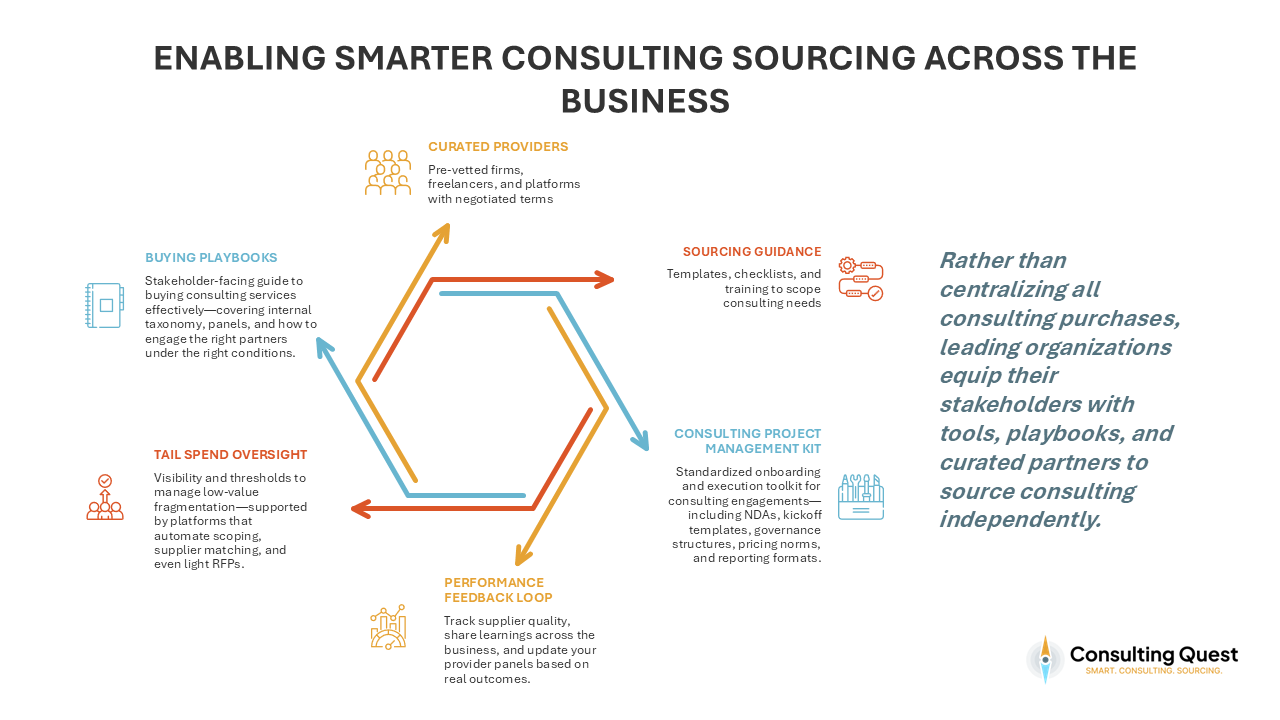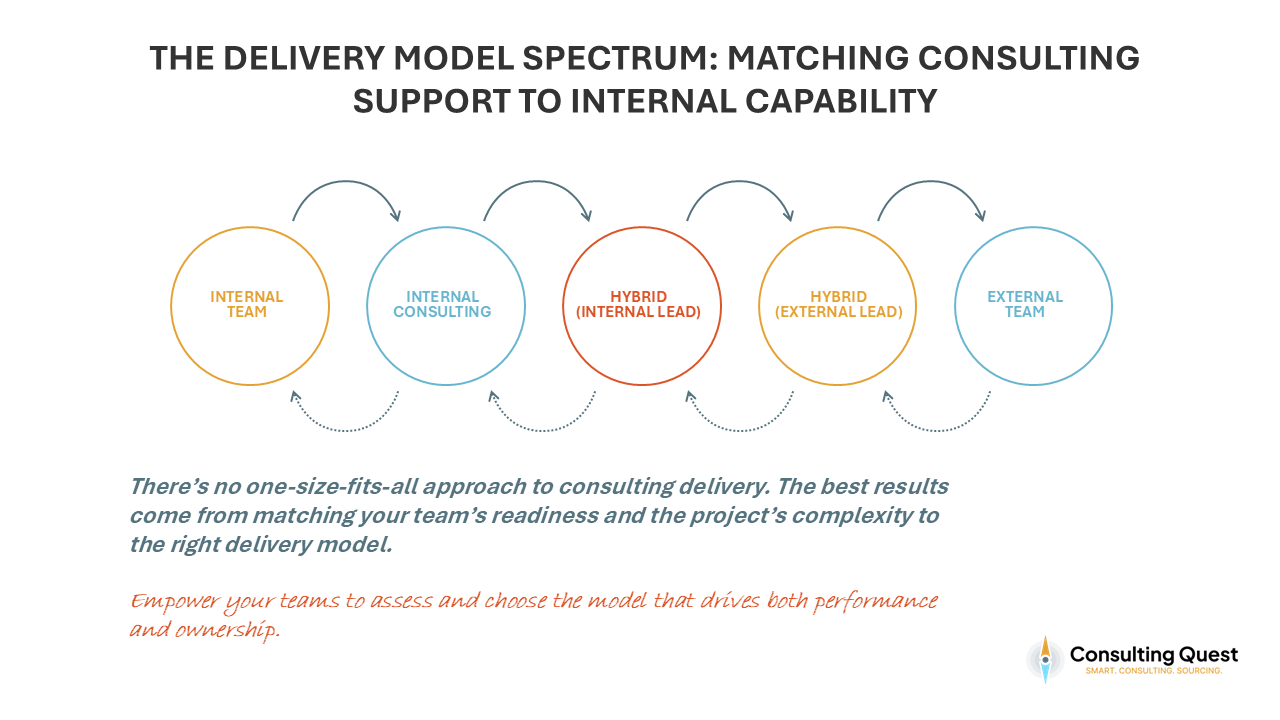Table of Contents
You’ve crafted a bold transformation roadmap. The destination is clear—accelerated growth, digital reinvention, operational excellence. But the journey? It’s constrained by limited budgets, overextended teams, and a growing need to show results faster than ever.
Consulting can help. The right external expertise can spark breakthroughs, accelerate execution, and de-risk complex change. But let’s be real—you can’t hire consultants for every initiative. Nor should you.
In today’s environment, strategy leaders must become architects of consulting leverage. That means knowing which projects genuinely warrant external support—and which can (and should) be handled in-house or through alternative models.
And here’s the good news: you’re no longer confined to the traditional “big firm” model. The consulting landscape has evolved dramatically. Today’s toolkit includes:
- Freelance consultants and expert networks offering specialized insight at a fraction of the cost
- Marketplaces and platforms that give you fast, direct access to vetted talent
- On-demand research and benchmarking services that eliminate the need for full-scale engagements
The challenge now is not whether to use consultants, but rather:
Where can consulting create the most value? What delivery model is right for each initiative? And how do you stretch every dollar to serve your most strategic goals?
This article is your guide to making those decisions. We’ll explore:
- How to map your initiative pipeline to identify high-leverage consulting opportunities
- How to use cash-generating projects to fund strategic work
- When to rely on internal teams vs. consultants vs. hybrid squads
- How to tap into the full spectrum of today’s consulting delivery models
In short, we’ll help you build a smarter, more agile, and more cost-effective way to use consulting as a strategic force multiplier—not just a line item.
The Strategic Utilization Challenge
Why Consulting Can’t Be Everywhere—Even If Your Strategy Is
Most transformation leaders face a sobering truth early in their roadmap: the ambition is vast, but the resources are limited. You may be managing a portfolio of 50+ initiatives—digital upgrades, operational overhauls, growth pilots, organizational redesigns. But your team (and budget) can realistically support only a fraction at full intensity.
Consulting firms can be force multipliers—but they’re also expensive and using them indiscriminately can quickly exhaust your budget. In fact, treating consulting as a universal plug-and-play solution often leads to:
- Diluted ROI across too many marginal engagements
- Over-reliance on external teams, reducing internal ownership
- Missed opportunities to build long-term capabilities in-house
The modern challenge isn’t just choosing the best consulting firm—it’s knowing when not to use one.
The Evolution of Consulting Demand
Consulting used to follow a straightforward path:
- Top-down strategy → hire a Tier-1 firm → execute over 6–12 months
But now, strategy evolves continuously, and so must execution. Organizations need fast starts, dynamic pivots, and delivery models that flex with the work.
At the same time, the consulting supply side has fragmented. You can now choose between:
- Global firms for large-scale change
- Boutiques for niche expertise
- Freelancers for speed and agility
- Marketplaces for project-based talent
- On-demand experts and direct research platforms
This diversity empowers you—but also forces a shift from relationship-based to project-based consulting decisions. You’re no longer buying a firm. You’re designing an ecosystem.
The Role of Strategic Consulting Utilization
That’s where strategic consulting utilization comes in. It’s the practice of:
Deploying the right consulting support, on the right projects, at the right time—using the right delivery model.
It’s not about cutting costs. It’s about increasing impact per dollar. And it requires three critical shifts:
- From intuition to structured decision-making
- From firm-centric to model-agnostic sourcing
- From reactive engagements to proactive portfolio planning
In the sections ahead, we’ll break down exactly how to make those shifts—starting with how to map your project pipeline and identify where consulting can generate the most leverage.
Mapping Your Strategy-to-Execution Pipeline
Segmenting Your Portfolio to Allocate Consulting Resources Strategically
With a finite consulting budget and a growing list of strategic initiatives, the first step toward smart utilization is to bring structure to your project landscape. That means shifting from a laundry list of initiatives to a clustered and prioritized roadmap.
The goal? Understand which initiatives truly move the needle—and which can wait, be handled in-house, or tackled through alternative models.
Define Strategic Priority Clusters
Start by grouping your initiatives into strategic clusters that reflect your transformation ambitions and operating context. A typical framework includes:
- Strategic Planning: Where to play, how to win, and resource allocation
e.g., entering new markets, building business unit strategies - Operational Effectiveness: Enhancing efficiency and performance
e.g., lean transformation, shared service implementation - Growth & Innovation: Activities that push beyond the current core
e.g., digital product incubation, partnerships, R&D strategy - Enablers and Governance: Steering and structuring transformation
e.g., board setup, data governance, change management models
This categorization helps you focus your consulting spend where it aligns most directly with strategic value creation—not just urgency or stakeholder pressure.
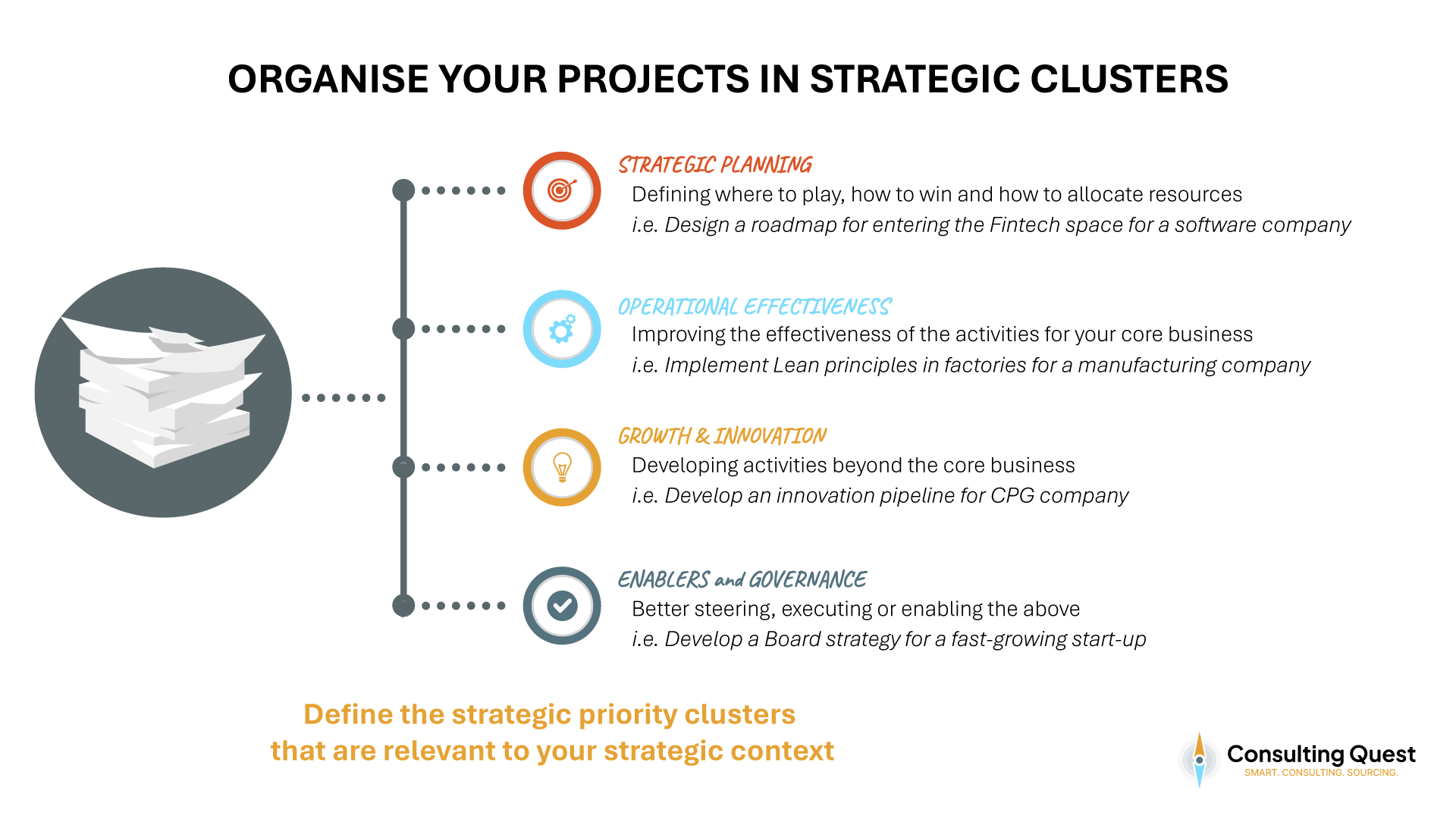
Build the Right Analytical Flow
Once projects are grouped, you can build a logical flow to evaluate them. A simplified five-step process looks like this:
- Assess Resource Allocation: Where is time, money, and attention currently spent?
- Define Strategic Clusters: Use the framework above to categorize initiatives.
- Conduct Priority Mapping: Evaluate each initiative by impact, urgency, and feasibility.
- Check Alignment: Are initiatives truly aligned with corporate strategy—or just legacy carry-overs?
- Build a Balanced Consulting Utilization Strategy: Decide which clusters or projects justify external support.
This approach ensures that consulting is not reactive or politically driven, but tied to measurable strategic intent.
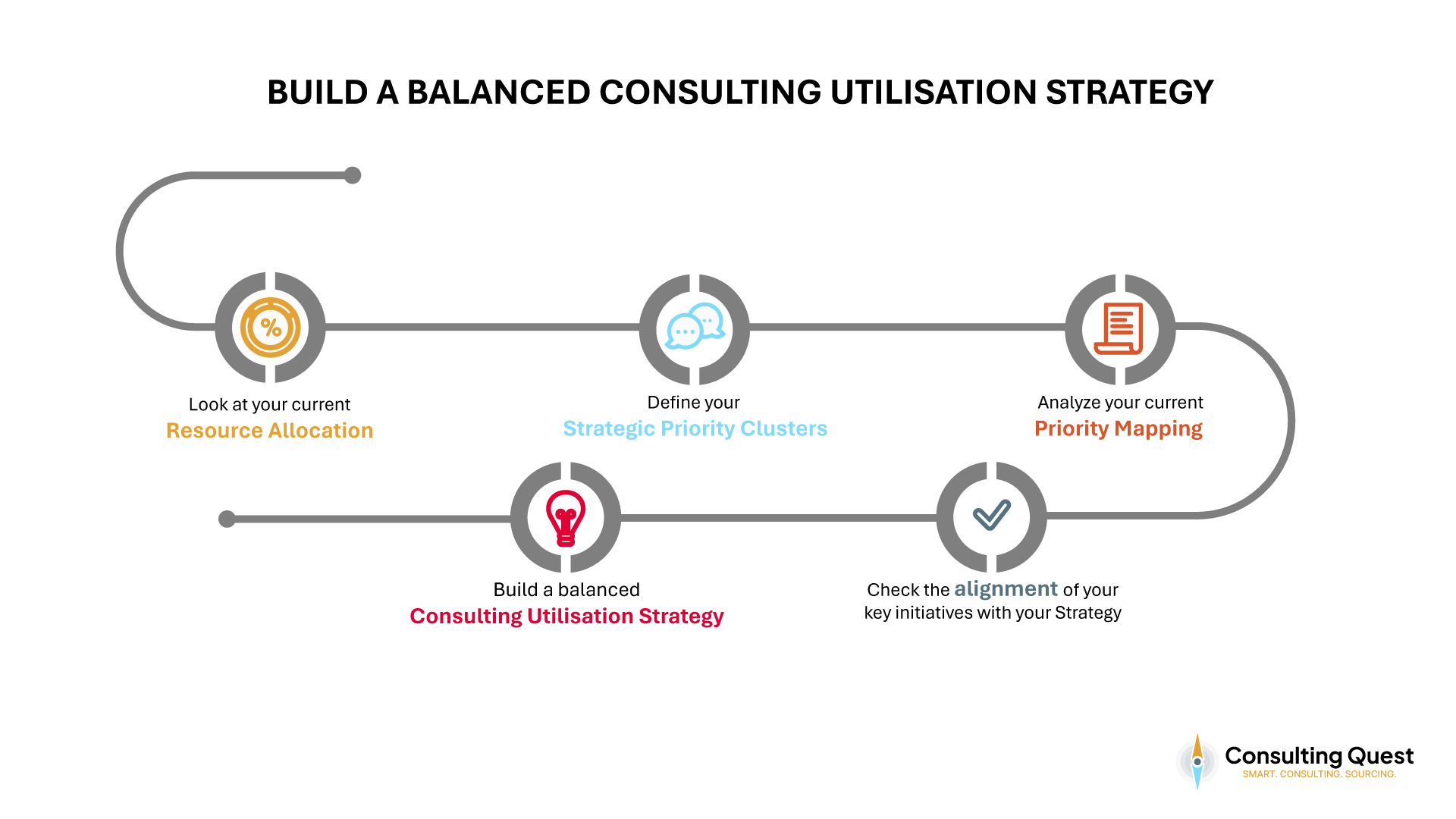
Prioritize Based on Impact and Funding Potential
Once you have a clear view of strategic clusters, layer in a strategic value vs. financial impact lens to support prioritization.
- High strategic value, high cash impact → Prioritize and consider external support
- High strategic value, low cash impact → Sequence and consider alternative models
- Low strategic value, high cash impact → Execute early to fund the roadmap
- Low strategic value, low cash impact → Deprioritize or defer
This analysis will feed directly into delivery model decisions—which we’ll tackle in the following sections.
Which Projects Should Be Externalized?
A Structured Framework to Decide What to Outsource—and Why
Not all projects deserve consulting support. And among those that do, not all should be fully externalized. Deciding what to outsource and what to keep in-house—requires more than instinct. It calls for structured evaluation across three dimensions:
- Externalizability – Can the project realistically be outsourced?
- Externalization Value – Will outsourcing create significant added value?
- Strategic Value – Is the project important enough to warrant external attention?
Once assessed, these three lenses will feed into a rational make-or-buy decision—your foundation for effective consulting demand management.
1. Assessing Externalizability: Can You Outsource the Work?
Before asking “Should we hire consultants?”, first ask “Can we?”
Not every project is suitable for external execution. Projects that are vague, politically entangled, or heavily dependent on internal dynamics may struggle when handed over to external consultants. To assess externalizability, consider four key questions:
- Can you define clear, tangible deliverables?
- Can you set a firm deadline with milestones?
- Is uncertainty low to medium? (High uncertainty often requires iterative, internal work)
- Do you have internal resources to manage or coordinate external work?
If the answer is mostly “yes,” the project is externalizable. If not, it may require internal ownership or hybrid execution.
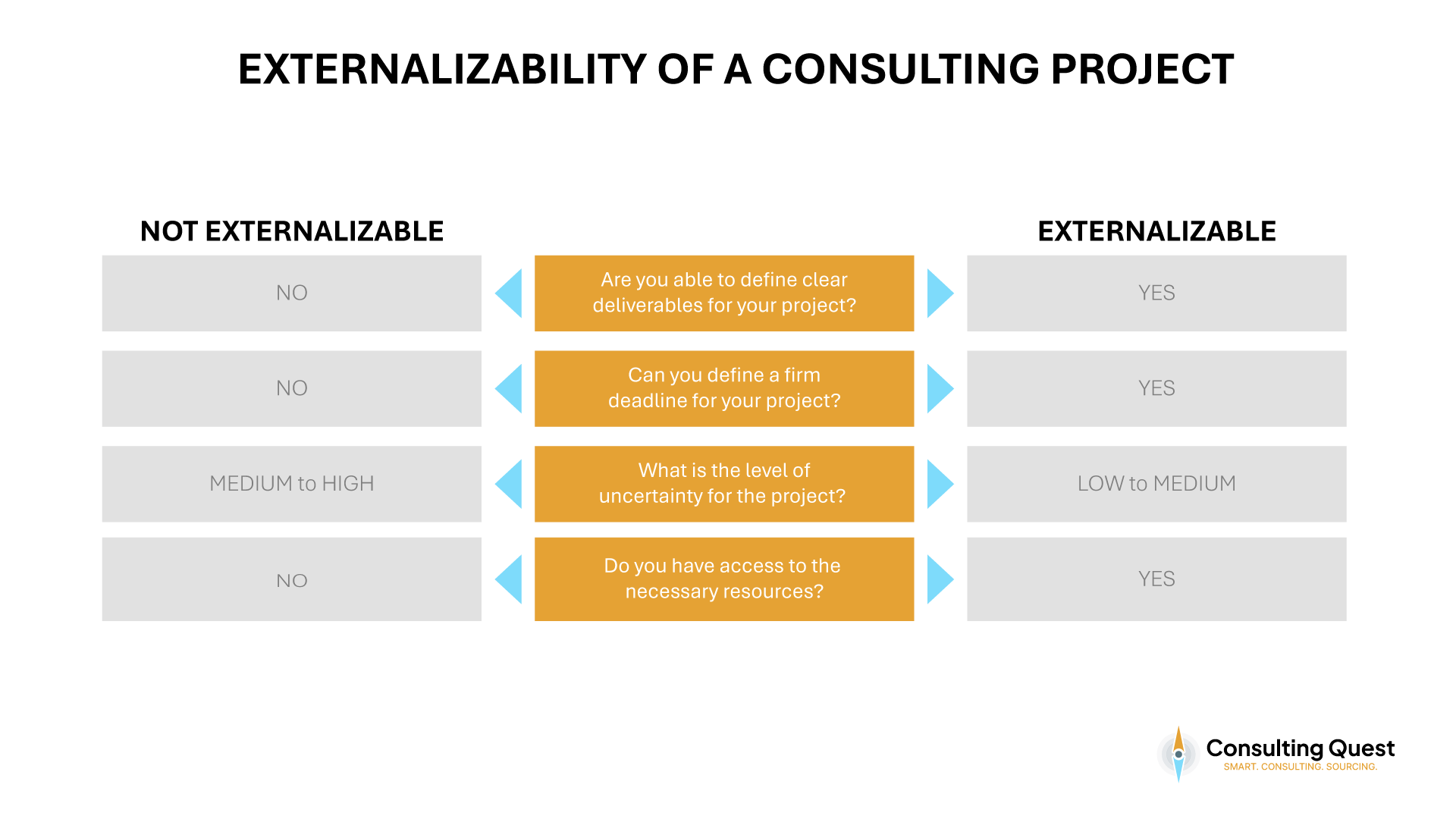
2. Assessing Externalization Value: Is It Worth Outsourcing?
Even if a project can be outsourced, that doesn’t mean it should be. The next question is: What added value will externalization deliver?
This is about leveraging what consultants bring: expertise, speed, objectivity, and tools. Evaluate value creation potential based on:
- Is the skillset required non-core or difficult to build internally?
- Will outsourcing improve speed, cost-efficiency, or quality?
- Is there a strategic reason to go external (e.g., neutrality, stakeholder alignment)?
- Do we lack the capabilities to supervise the project internally?
- Can external providers deliver the service credibly?
If externalization clearly improves the business case, it’s worth considering—even if internal resources technically exist.
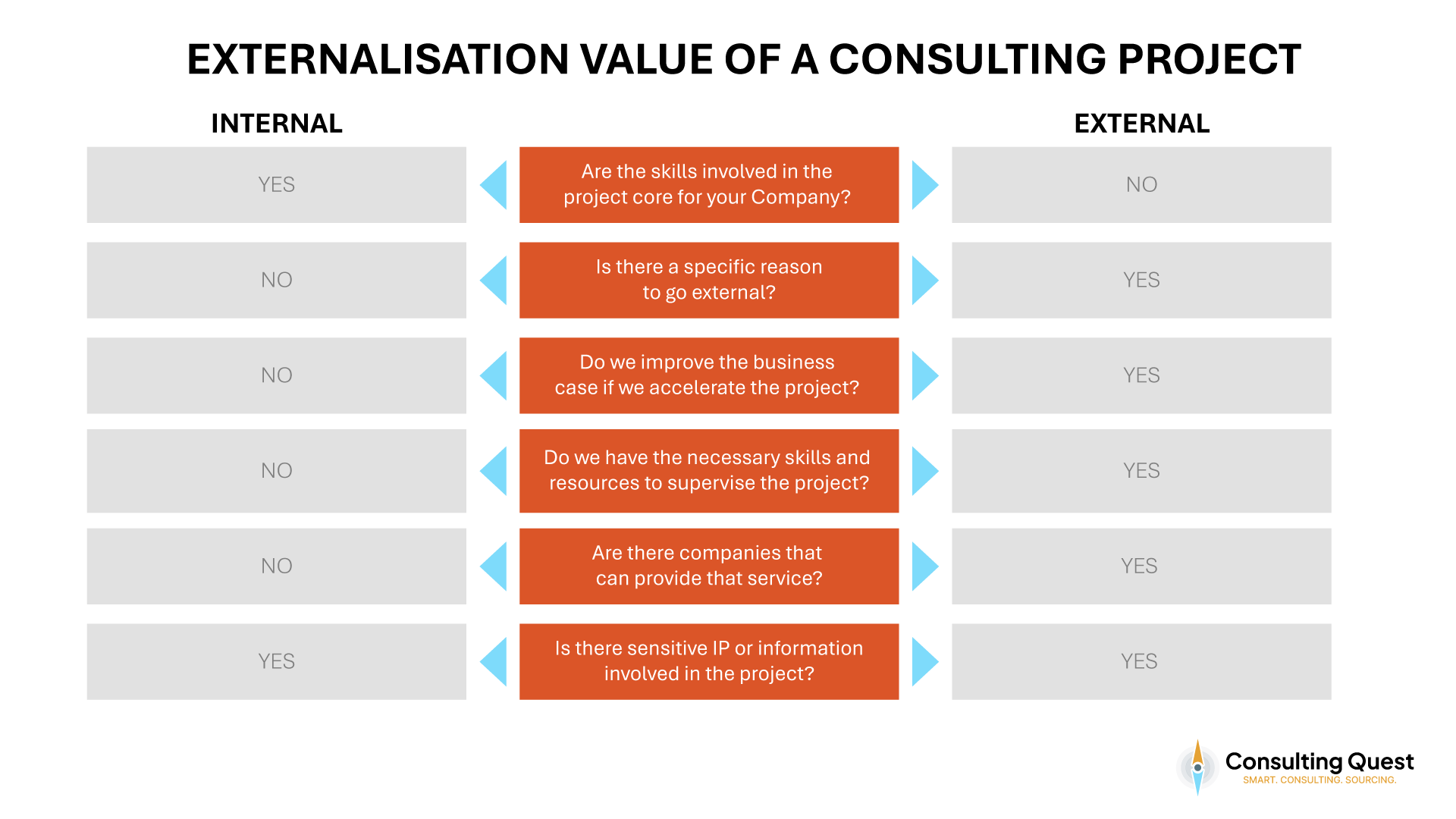
3. Assessing Strategic Value: Is the Project Worth Prioritizing?
A project might be externalizable and valuable to outsource, but if it doesn’t support your transformation goals, it shouldn’t be a candidate for scarce consulting resources.
Ask:
- Is the project directly tied to strategic priorities or enablers?
- Does it offer moderate to high business impact?
- Are we ready to fund and execute this now?
- Will the competencies gained be reused in future projects?
Projects that meet these criteria are clear candidates for execution—whether internal or external.
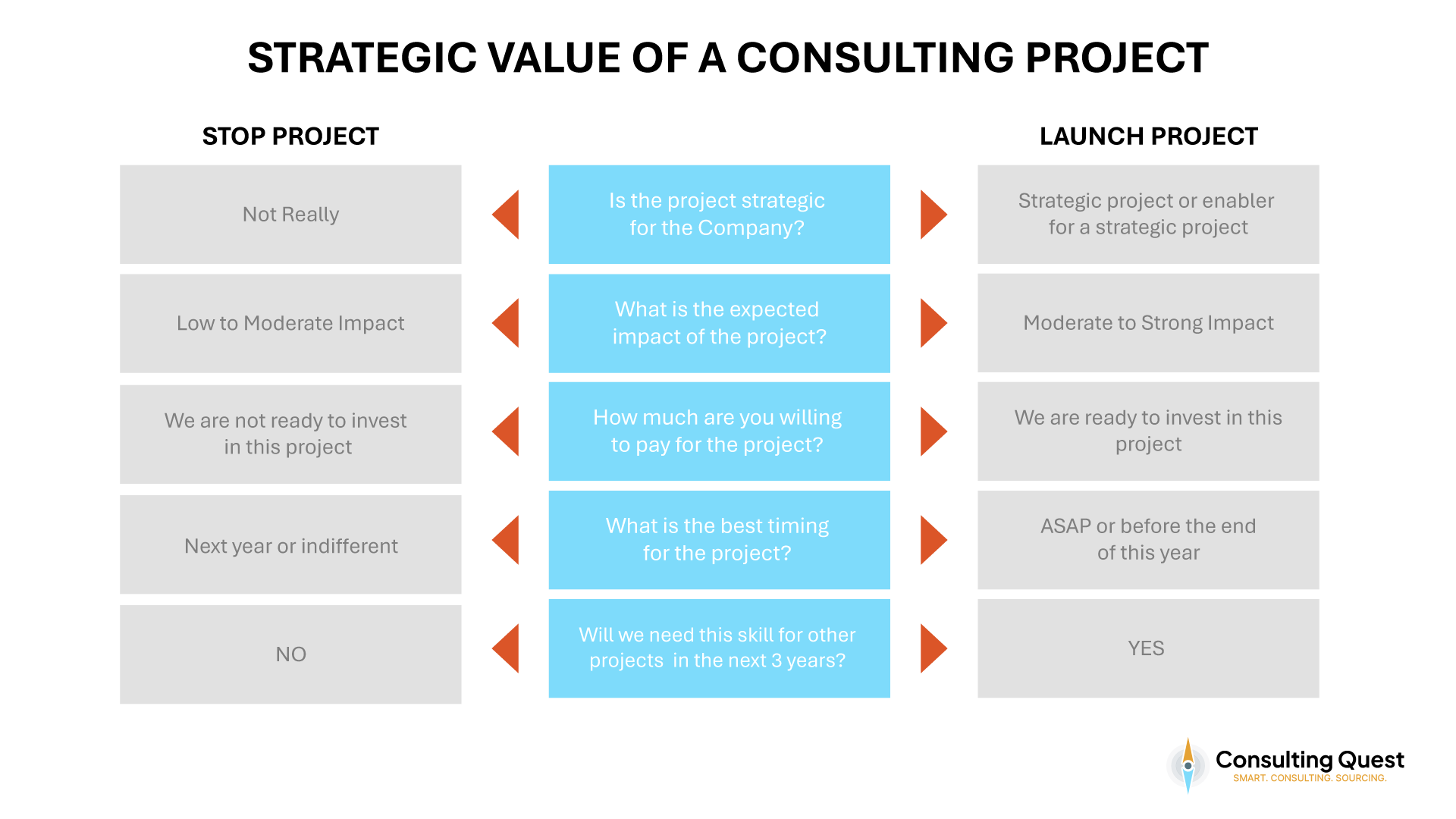
Bringing It Together: Make-or-Buy and Demand Management
When you combine these three assessments—externalizability, externalization value, and strategic importance—you have the data needed for a smart make-or-buy decision.
Use a matrix to classify your initiatives:
- Strong Strategic Value + High Externalization Value → Externalize (ideal for consulting support)
- Strong Strategic Value + Low Externalization Value → Keep in-house (or consider hybrid models)
- Low Strategic Value + High Externalization Value → Defer or deprioritize (nice-to-have)
- Low on all dimensions → Eliminate or consolidate
This isn’t just a sourcing tactic—it’s the foundation of consulting demand management. By applying this lens consistently, strategy leaders can:
- Filter out non-essential consulting requests early
- Focus external spend on what truly moves the needle
- Push internal teams to own low-strategic-value or low-complexity work
- Enable better negotiation and governance with providers
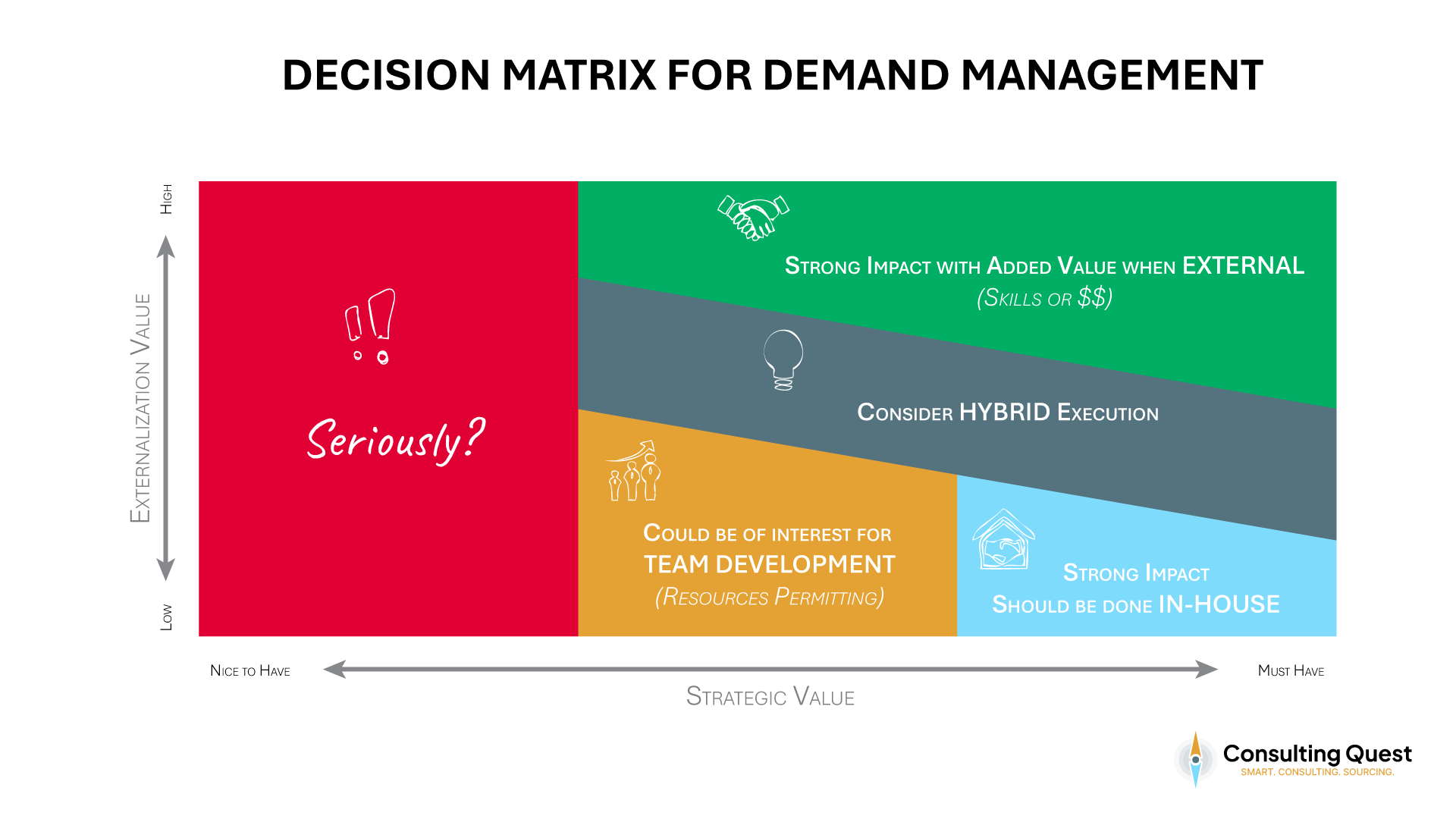
With this structured approach, you not only decide what to outsource, but why. And that clarity is essential when optimizing limited consulting budgets. Learn more about implementing this approach in our demand management guide.
Leverage Quick-Win, Cash-Flow Projects to Fund Strategy
Why Not All Projects Are Strategic—but Some Can Help Pay for the Ones That Are
In a constrained environment, you don’t just prioritize consulting for strategic impact—you fund it. And one of the smartest ways to do that is by deliberately sequencing high-cash-impact, lower-strategic-value projects to unlock resources for higher-value transformation work.
This is a key lever in consulting utilization strategy: use operational efficiency to fund strategic reinvention.
Use Operational Levers to Build Your Transformation Budget
Projects that generate fast financial returns may not be “visionary,” but they’re essential. They create internal credibility, momentum, and—most importantly—cash. Think of them as the engine room that powers your consulting budget.
Typical quick-win project examples:
- Procurement optimization or tail-spend rationalization
- Working capital improvement
- Indirect cost reduction (e.g., G&A streamlining)
- Price realization and margin improvement
- IT licensing or service renegotiation
These projects often have high externalization value and low emotional or political complexity, making them perfect candidates for external support via boutique firms or specialists.
These initiatives don’t compete with strategic projects—they enable them.
Sequence for Impact: Fund-Then-Transform
A useful sequencing logic is:
- Start with quick wins
- Generate measurable savings in 3–6 months
- Demonstrate ROI on consulting engagement
- Reinvest savings in strategic projects
- Use consulting selectively
- Deploy external support where ROI is highest
- Build internal momentum and C-suite confidence
- Ramp into strategic priorities
- Activate roadmap items that were previously unfunded
- Consider larger-scale transformation with consultant-led support
This dynamic allows you to balance near-term value creation with long-term investment. Rather than cutting strategic priorities to fit the budget, you grow the budget by harvesting low-hanging fruit.
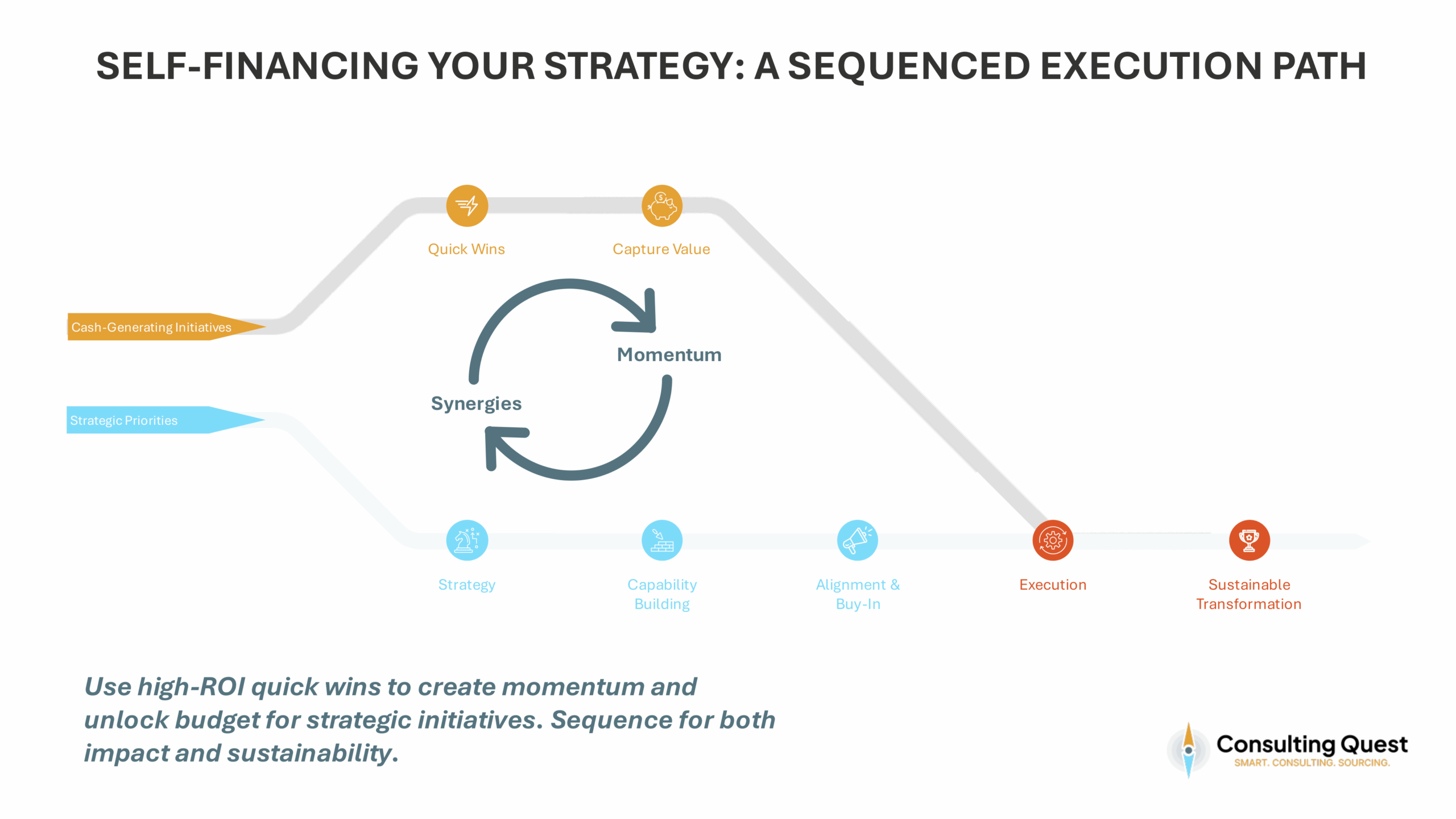
Internal Champions and Procurement as Enablers
Don’t underestimate the internal politics of funding strategy. Quick-win projects can help you:
- Secure executive buy-in for later-phase initiatives
- Demonstrate the business case for external spending
- Justify flexible budgeting and multi-phase consultant engagement
Here, procurement becomes a strategic ally, not just a gatekeeper. By building visibility into spend, supplier performance, and value delivered, they help maintain the discipline of “earned consulting capacity.”
Linking Back to Demand Management
This funding logic ties directly to your make-or-buy and consulting portfolio decisions:
- Quick-win projects often fall in the medium strategic, high externalization value quadrant
- They are ideal to outsource when internal capacity is limited and urgency is high
- Their value is not in being “transformational,” but in making transformation possible
Smart leaders treat these projects not as detours—but as fuel.
Rethinking the Consulting Toolbox – New Models, More Levers
How to Tap into the New Consulting Ecosystem Without Losing Control
In the past, companies had a simple consulting choice: engage a full-service firm, often through a relationship-driven, top-down process. But the landscape has changed.
Today, the consulting industry has exploded into a modular, flexible, and disaggregated ecosystem—where you no longer need to buy the entire playbook to get the expertise you need.
Strategy and transformation leaders now have access to a broader consulting toolbox—but to use it effectively, they must understand not just what’s available, but how and when to use it.
The New Ecosystem: Beyond the Big Firm
Let’s break down the most common models you can deploy beyond traditional consulting firms:
| Model | Best For | Pros | Watch-outs |
| Freelance Consultants / Boutique Specialists | Targeted expertise, fast starts, lower budgets | Lower cost, deep expertise, flexible engagement | Capacity limits, less brand weight, quality varies |
| Expert Networks & Talent Marketplaces (e.g., GLG, Catalant, Talmix) | Insight access, market validation, team augmentation | Speed, niche knowledge, no long-term commitments | Requires curation, may lack delivery ownership |
| Direct Data Platforms (e.g., Statista, CB Insights, Pitchbook) | Benchmarking, trends, market data | On-demand, cost-effective, reusable | No synthesis or tailored insight |
| Research-as-a-Service (e.g., AlphaSense, NewtonX) | Custom validation, early scoping, support for internal teams | Faster than traditional firms, curated outputs | Doesn’t replace full project delivery or change leadership |
The key takeaway: You don’t need a consulting firm for every insight. Sometimes, a former consultant on-demand—or a well-designed search on a data platform—gets the job done.
Hiring Former Consultants: A Rising Internal Asset
Many companies now hire former consultants directly into transformation teams, strategy offices, or COEs. This creates internal capacity for consulting-grade thinking—without the markup.
These hires can:
- Lead initiatives that would otherwise go to external firms
- Manage and coach DIY teams or hybrid models
- Act as intelligent buyers and orchestrators of niche expertise
In essence, they allow you to internalize a significant portion of your consulting demand—and often improve continuity, alignment, and cost control in the process.
Educate Your Stakeholders: Build a “Consulting Buyer’s Handbook”
The power of this ecosystem is only realized if your organization knows how to use it. Without clear guidelines, stakeholder DIY procurement can turn into tail spend chaos—fragmented, ungoverned, and hard to track. More on how to manage the tail spend, click here.
To manage this, progressive organizations are developing an internal “Consulting Buyer’s Handbook”, including:
- Taxonomy of consulting options: Firms, freelancers, experts, platforms, data
- When to use what: Based on scope, speed, budget, sensitivity, IP, and expertise
- How to source smartly: From scoping guidance to onboarding and governance
- Cost benchmarking: What to expect and how to avoid overpaying
- Approved partners and marketplaces: Curated sources to reduce risk and lead time
- Tail-spend rules: Budget thresholds, reporting, and exception handling
This isn’t about over-policing—it’s about empowering business users to source smarter, faster, and within strategic guardrails.
Keep Tail Spend Under Control—Without Killing Agility
Used well, this ecosystem gives you greater agility and lower cost—especially for smaller, lower-risk projects. But without structure, it can become a procurement blind spot.
To balance flexibility with control:
- Define which models are preferred for each type of need
- Establish spend visibility tools and thresholds
- Create lightweight intake processes that guide, not block
- Build feedback loops to track supplier performance across all channels
Guiding the Ecosystem, Not Controlling It
Let’s face it: stakeholders will continue to source consulting support on their own. And that’s not a failure—it’s an opportunity.
Procurement’s job isn’t to block agility. It’s to channel it. By providing tools, frameworks, and pre-vetted partners, you reduce friction for the business—while still maintaining strategic alignment, cost control, and visibility.
What works best?
- Curated supplier lists: Former consultants, boutiques, platforms, and experts—already assessed and negotiated for favorable terms
- Flexible sourcing playbooks: Tailored guidelines for different project types, so stakeholders can move fast and make informed choices
- Governed autonomy: Budget thresholds, fast-track approvals, and light oversight to manage risk without killing momentum
- Shared KPIs and tracking: Light-touch performance tracking across both formal and informal consulting activity
In short: consulting procurement becomes a strategic enabler, not a centralized bottleneck.
With the right infrastructure in place, you empower business units to act independently—while ensuring their choices still serve the broader transformation and spend optimization goals.
Choosing the Right Delivery Model – Internal, External, or Hybrid
Getting Beyond “In-House vs. Consultants”: It’s a Spectrum, Not a Binary
When it comes to executing strategic projects, the choice is no longer just “internal vs. external.” In reality, most initiatives sit somewhere along a delivery model spectrum—ranging from fully internal execution to fully outsourced consulting.
Your goal isn’t to pick a side—it’s to choose the model that delivers the most value, given your context.
The Delivery Model Spectrum
Visualize delivery options as a scale:
Internal Team >> Internal Consulting >> Hybrid (Lead Internal) >> Hybrid (Lead External) >> Consulting Firm |
Each step reflects increasing reliance on external expertise and decreasing internal ownership. The right model depends on:
- Internal capabilities
- Strategic complexity
- Time and bandwidth
- Political sensitivity
- Consulting budget available
Step 1: Assess Internal Capabilities and “Consulting Savviness”
Before choosing a model, assess your internal team’s readiness to lead or co-lead a consulting project. Two questions matter:
- Do we have the bandwidth to run this internally?
- Do we have the skills and experience to structure and drive external contributions effectively?
Use the following framework:
| Team Profile | Characteristics | Best Delivery Models |
| Consulting-Savvy Team | Previous project experience, knows how to scope, manage, and absorb consulting work | Hybrid (Lead Internal), Expert Freelancers, Internal Consulting Team |
| Emerging Team | Has subject matter knowledge but little consulting engagement experience | Hybrid (Lead External), Boutique Firms, Guided Models |
| Unstructured/Overstretched Team | Limited capacity or strategic execution experience | Full-service Consulting Firm, Embedded Consultants |
Step 2: Match the Model to the Project
| Project Type | Ideal Delivery Model |
| Strategic planning with high internal visibility | Hybrid or Internal Consulting Unit |
| Operational cost reduction | Internal + Targeted Consulting Expertise |
| Capability building / skill transfer | Hybrid with embedded coaching |
| Highly political initiative (e.g., org redesign) | External firm or neutral facilitator |
| Repeatable processes | Internal team with templates and playbooks |
| Speed-critical transformation | External-led, with internal support |
Step 3: Choose the Level of Consultant Ownership
For each project, decide what role consultants should play:
| Role of Consultants | Description | Example Use Cases |
| Advisor | Expert input, but client leads | Market validation, benchmarking |
| Co-Pilot | Shared ownership | Strategy formulation, change program |
| Lead Driver | Consultants own delivery, client steers | M&A integration, turnaround |
The more your internal team can manage, the less external support you need. But the reverse is also true: forcing internal execution where skills are missing leads to delays, cost overruns, and poor adoption.
Final Thought: There’s No One-Size-Fits-All
Trying to standardize delivery models across all teams and all projects is a mistake. Instead, equip your organization to:
- Assess internal readiness
- Choose the right model for each project
- Balance control, cost, and capability
And remember: hybrid doesn’t mean compromise—when done well, it’s the best of both worlds.
Operationalizing Strategic Consulting Utilization
From Framework to Practice: Embedding Smart Consulting Use into the Way You Work
You’ve mapped your project portfolio, chosen the right sourcing models, and built a smarter delivery playbook. But to turn that strategy into day-to-day impact, you need to operationalize consulting utilization.
That means putting systems in place so the right decisions happen automatically—without relying on one person or department to intervene every time.
1. Embed Consulting Prioritization into Planning & Budgeting
Consulting shouldn’t be an afterthought. It should be integrated into how you:
- Build your annual transformation roadmap
- Define project-level resourcing plans
- Review business unit budgets
Practical ways to embed:
- Require project owners to specify if external support is needed—and why
- Include sourcing model discussions in strategic planning cycles
- Link consulting budget allocation to project priority and internal capability assessment (e.g., “Consulting-Justified Score”)
2. Create Lightweight Intake and Approval Workflows
Don’t kill agility with bureaucracy—but don’t let unmanaged demand run wild either.
A simple intake process can:
- Confirm internal resources have been considered first
- Route sourcing to the right model (internal, external, hybrid)
- Trigger relevant toolkits: playbooks, templates, approved providers
For example: Projects under a €50K threshold may be fast-tracked if they align with predefined use cases and use curated partners.
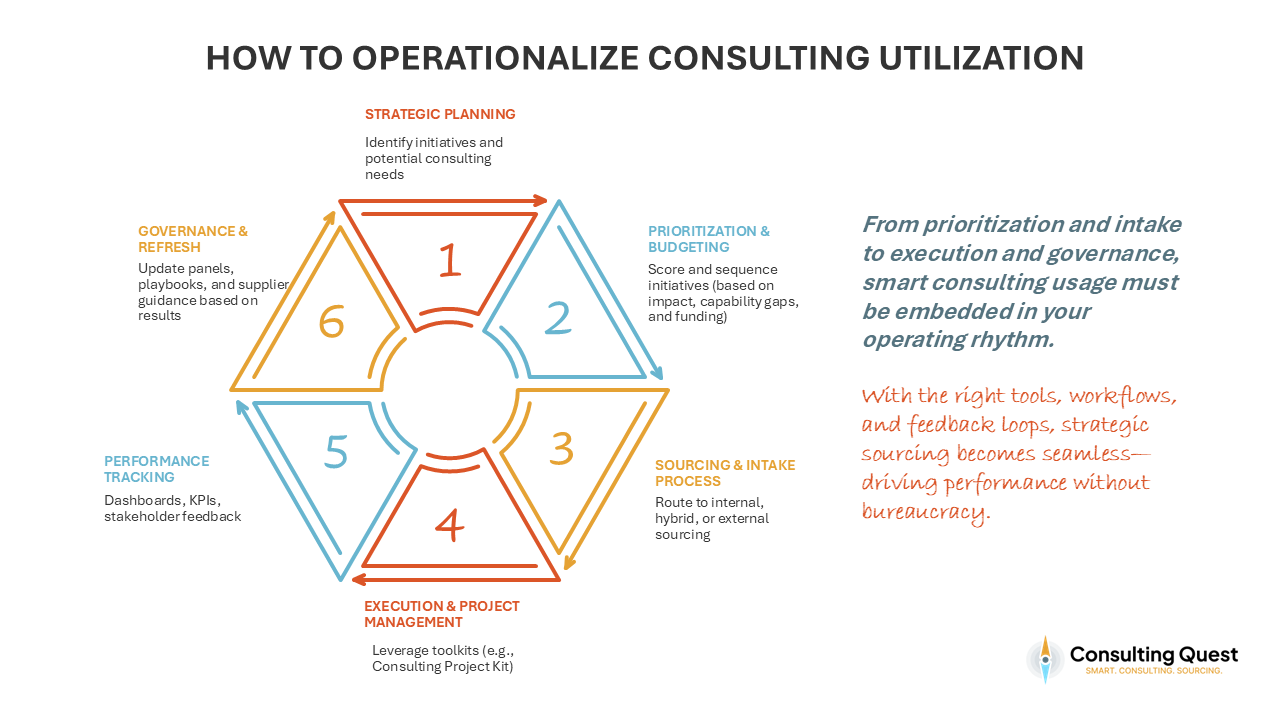
3. Build Visibility with Dashboards and KPIs
To manage consulting strategically, you need visibility. This includes:
- Spend by project, business unit, and provider
- Sourcing models used (internal, hybrid, external)
- Value delivered (ROI, outcomes, stakeholder satisfaction)
Even a basic dashboard showing consulting “burn rate” vs. value realized can help leaders course-correct in real time.
4. Make Governance a Value Enabler, Not a Bottleneck
Governance isn’t about control for its own sake. It’s about alignment, risk mitigation, and ROI tracking. A good governance model should:
- Include quarterly consulting portfolio reviews
- Flag repeat engagements and suppliers for deeper evaluation
- Use insights to refresh provider panels, playbooks, and internal tools
5. Evolve Based on Feedback and Maturity
No consulting utilization strategy is perfect from day one. Build feedback loops:
- From project teams (on what worked and what didn’t)
- From consultants (on client-side readiness and effectiveness)
- From procurement and finance (on spend visibility and compliance)
As teams grow more consulting-savvy, shift toward more decentralized models. As complexity grows, re-centralize playbooks and support.
Final Thought: It’s a System, Not a Policy
Operationalizing consulting utilization is not just about approval workflows. It’s about building a system where:
- Smart sourcing happens by design
- Stakeholders are equipped, not controlled
- The company learns and adapts as it grows
When done right, consulting becomes a true strategic lever—not a tactical purchase.
Conclusion: Make Consulting a Strategic Lever, Not a Cost Center
The days of reactive, relationship-based consulting sourcing are over. In today’s environment, consulting must be used strategically—not sparingly.
That doesn’t mean spending more. It means spending smarter:
- Prioritizing the projects that truly deserve external support
- Sequencing initiatives to fund your strategy through impact
- Leveraging the full consulting ecosystem—from firms to platforms to freelancers
- Empowering your teams to source well, even when they move fast
- And operationalizing smart utilization so the system works at scale
There’s no one model that fits every company, every team, or every transformation. But what the best-performing organizations share is this:
They treat consulting not as a cost to contain, but as a capability to orchestrate.
With the right delivery model, sourcing toolkit, and internal education, you can do more with less—and turn consulting into a true engine for transformation.
Want to build a smarter consulting sourcing strategy for your organization?
Book a free consultation with Consulting Quest and discover how to align your transformation roadmap, supplier ecosystem, and sourcing model to drive more value from every engagement.

